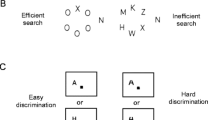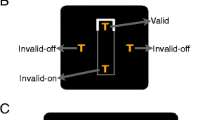Abstract
Tipper (1985; Q J Exp Psychol A 37:571–590) has suggested that competing responses programmed to distracting stimuli are inhibited based on their relationship to the action being performed. The present paper reports two experiments designed to examine the influence of the terminal action of a task on the allocation of visual attention. Taken together the results suggest that when engaging targets in an environment, which includes distracting stimuli, competing responses are likely to be programmed in parallel and that the relationship between competing responses can include both spatial position and action characteristics.

Similar content being viewed by others
Notes
Originally, the volunteers who participated in experiment 2a, where engagement of the target device was required, also completed the protocol for experiment 2b (i.e., the simple aiming movements). However, as an anonymous reviewer pointed out, this within-participant procedure has the potential for carry-over effects. Specifically, experience with the actions in experiment 2a could affect performance in experiment 2b. Thus we reran experiment 2b with a different group of participants.
There was no distractor main effect for total time in experiment 2b (P>0.05)
Although it is often assumed that location and action are organized hierarchically (Rosenbaum et al. 1983), the interaction between location and action in experiment 1 indicates that these planning processes may overlap in time
References
Allport A (1987) Selection for action: some behavioural and neurophysiological considerations of attention and action. In: Heuer H, Sanders AF (eds) Perspectives on perception and action. Erlbaum, Hillsdale NJ, pp 395–419
Castiello U (1996) Grasping a fruit: selection for action. JExp Psychol Hum Percept Perform 22:582–603
Chua R, Elliott D (1993) Visual regulation of manual aiming. HumMov Sci 12:365–401
Elliott D, Binsted G, Heath M (1999) The control of goal-directed limb movements: correcting errors in the trajectory. Hum Move Sci 18:121–136
Henry FM, Rogers DE (1960) Increased response latency for complicated movements and a "memory drum" theory of neuromotor reaction. Res Q 31:448–458
Humphreys GW, Riddoch MJ (2000) One more cup of coffee for the road: object-action assemblies, response blocking and response capture after frontal lobe damage. Exp Brain Res 133:81–93
Jervis C, Bennett K, Thomas J, Lim S, Castiello U (1999) Semantic category interference effects upon the reach-to-grasp movement. Neuropsychologia 37:857–868
Kritikos A, Bennett KMB, Dunai J, Castiello U (2000) Interference from distractors in reach-to grasp movements. Q J Exp Psychol A 53:131–151
Lyons J, Elliott D, Ricker KL, Weeks DJ, Chua R (1999) Action-centred attention in virtual environments. Can J Exp Psychol 53:176–187
Meegan DV, Tipper SP (1998) Reaching into cluttered visual environments: Spatial and temporal influences of distracting objects. Q J Expl Psychol A 51: 225–249
Milgram P (1987) A spectacle-mounted liquid-crystal tachistoscope. Behavi Res Methods Instrum Comput 19:449–456
Pratt J, Abrams RA (1994) Action-centred inhibition: effects of distractors on movement planning and execution. Hum Mov Sci 13:245–254
Rosenbaum DA, Kenny SB, Derr MA (1983) Hierarchical control of rapid movement sequences. J Exp Psychol Hum Percept Perform 9:86–102
Tipper SP, Lortie C, Baylis GC (1992) Selective reaching: evidence for action-centered attention. J Exp Psychol Hum Percept Perform 18:891–905
Tipper SP, Howard LA, Jackson SR (1997) Selective reaching to grasp: evidence for distractor interference effects. Visual Cogn 4:1–38
Treisman A (1988) Features and objects: the fourteenth Bartlett Memorial Lecture. Q J Exp Psychol A 40:201–237
Van der Heijden AHC (1993) The role of position in object selection in vision. Psychol Res 56:44–58
Welsh TN, Elliott D, Weeks DJ (1999) Hand deviations toward distractors: evidence for response competitions. Exp Brain Res 127:207–212
Acknowledgements
The authors thank John Moroz for his technical assistance. D.J. Weeks, D. Elliott, R. Chua and E.A. Roy acknowledge the support of the Natural Sciences and Engineering Research Council of Canada.
Author information
Authors and Affiliations
Corresponding author
Rights and permissions
About this article
Cite this article
Weir, P.L., Weeks, D.J., Welsh, T.N. et al. Influence of terminal action requirements on action-centered distractor effects. Exp Brain Res 149, 207–213 (2003). https://doi.org/10.1007/s00221-002-1358-4
Received:
Accepted:
Published:
Issue Date:
DOI: https://doi.org/10.1007/s00221-002-1358-4




